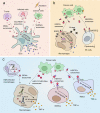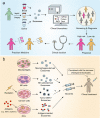The function and clinical application of extracellular vesicles in innate immune regulation
- PMID: 32203193
- PMCID: PMC7109106
- DOI: 10.1038/s41423-020-0391-1
The function and clinical application of extracellular vesicles in innate immune regulation
Abstract
The innate immune system plays a crucial role in the host defense against viral and microbial infection. Exosomes constitute a subset of extracellular vesicles (EVs) that can be released by almost all cell types. Owing to their capacity to shield the payload from degradation and to evade recognition and subsequent removal by the immune system, exosomes efficiently transport functional components to recipient cells. Accumulating evidence has recently shown that exosomes derived from tumor cells, host cells and even bacteria and parasites mediate the communication between the invader and innate immune cells and thus play an irreplaceable function in the dissemination of pathogens and donor cell-derived molecules, modulating the innate immune responses of the host. In this review, we describe the current understanding of EVs (mainly focusing on exosomes) and summarize and discuss their crucial roles in determining innate immune responses. Additionally, we discuss the potential of using exosomes as biomarkers and cancer vaccines in diagnostic and therapeutic applications.
Keywords: cancer diagnosis; exosome; extracellular vesicles; immunotherapy; innate immune.
Conflict of interest statement
The authors declare no competing interests.
Figures



Similar articles
-
The distinct roles of exosomes in innate immune responses and therapeutic applications in cancer.Eur J Pharmacol. 2022 Oct 15;933:175292. doi: 10.1016/j.ejphar.2022.175292. Epub 2022 Sep 20. Eur J Pharmacol. 2022. PMID: 36150532 Review.
-
Extracellular Vesicles Deliver Host and Virus RNA and Regulate Innate Immune Response.Int J Mol Sci. 2017 Mar 20;18(3):666. doi: 10.3390/ijms18030666. Int J Mol Sci. 2017. PMID: 28335522 Free PMC article. Review.
-
Extracellular Vesicles Released by Herpes Simplex Virus 1-Infected Cells Block Virus Replication in Recipient Cells in a STING-Dependent Manner.J Virol. 2018 Aug 29;92(18):e01102-18. doi: 10.1128/JVI.01102-18. Print 2018 Sep 15. J Virol. 2018. PMID: 29976662 Free PMC article.
-
Functions of Cancer-Derived Extracellular Vesicles in Immunosuppression.Arch Immunol Ther Exp (Warsz). 2017 Aug;65(4):311-323. doi: 10.1007/s00005-016-0453-3. Epub 2017 Jan 18. Arch Immunol Ther Exp (Warsz). 2017. PMID: 28101591 Free PMC article. Review.
-
The Yin and Yang of tumour-derived extracellular vesicles in tumour immunity.J Biochem. 2021 Mar 5;169(2):155-161. doi: 10.1093/jb/mvaa132. J Biochem. 2021. PMID: 33226400
Cited by
-
A new horizon of precision medicine: combination of the microbiome and extracellular vesicles.Exp Mol Med. 2022 Apr;54(4):466-482. doi: 10.1038/s12276-022-00748-6. Epub 2022 Apr 22. Exp Mol Med. 2022. PMID: 35459887 Free PMC article. Review.
-
Lipidic Profile Changes in Exosomes and Microvesicles Derived From Plasma of Monoclonal Antibody-Treated Psoriatic Patients.Front Cell Dev Biol. 2022 Jun 13;10:923769. doi: 10.3389/fcell.2022.923769. eCollection 2022. Front Cell Dev Biol. 2022. PMID: 35769256 Free PMC article.
-
Why India needs more exosome research for cancer?Ann Med Surg (Lond). 2022 Jul 31;80:104265. doi: 10.1016/j.amsu.2022.104265. eCollection 2022 Aug. Ann Med Surg (Lond). 2022. PMID: 35958283 Free PMC article. No abstract available.
-
Toxic and Teratogenic Effects of Prenatal Alcohol Exposure on Fetal Development, Adolescence, and Adulthood.Int J Mol Sci. 2021 Aug 16;22(16):8785. doi: 10.3390/ijms22168785. Int J Mol Sci. 2021. PMID: 34445488 Free PMC article. Review.
-
Extracellular vesicles in obesity and its associated inflammation.Int Rev Immunol. 2022;41(1):30-44. doi: 10.1080/08830185.2021.1964497. Epub 2021 Aug 23. Int Rev Immunol. 2022. PMID: 34423733 Free PMC article. Review.
References
Publication types
MeSH terms
LinkOut - more resources
Full Text Sources
Other Literature Sources

